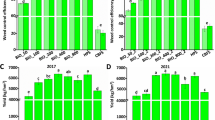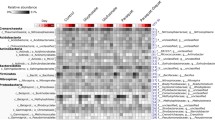Abstract
Fomesafen is a diphenyl ether herbicide that has an important role in the removal of broadleaf weeds in bean and fruit tree fields. However, very little information is known about the effects of this herbicide on soil microbial community structure and activities. In the present study, laboratory experiments were conducted to examine the effects of different concentrations of fomesafen (0, 10, 100, and 500 μg/kg) on microbial community structure and activities during an exposure period of 60 days, using soil enzyme assays, plate counting, and denaturing gradient gel electrophoresis (DGGE). The results of enzymatic activity experiments showed that fomesafen had different stimulating effects on the activities of acid phosphatase, alkaline phosphatase, and dehydrogenase, with dehydrogenase being most sensitive to fomesafen. On the tenth day, urease activity was inhibited significantly after treatment of different concentrations of fomesafen; this inhibiting effect then gradually disappeared and returned to the control level after 30 days. Plate counting experiments indicated that the number of bacteria and actinomycetes increased in fomesafen-spiked soil relative to the control after 30 days of incubation, while fungal number decreased significantly after only 10 days. The DGGE results revealed that the bacterial community varied in response to the addition of fomesafen, and the intensity of these six bands was greater on day 10. Sequencing and phylogenetic analyses indicated that the six excised DGGE bands were closely related to Emticicia, Bacillus, and uncultured bacteria. After 10 days, the bacterial community exhibited no obvious change compared with the control. Throughout the experiment, we concluded that 0–500 μg/kg of fomesafen could not produce significant toxic effects on soil microbial community structure and activities.





Similar content being viewed by others
References
Aislabie, J. M., Chhour, K. L., Saul, D. J., Miyauchi, S., Ayton, J., Paetzold, R. F., et al. (2006). Dominant bacteria in soils of Marble Point and Wright Valley, Victoria Land, Antarctica. Soil Biology and Biochemistry, 38, 3041–3056.
Andreoni, V., Cavalca, L., Rao, M. A., Nocerino, G., Bernasconi, S., Dell’Amico, E., et al. (2004). Bacterial communities and enzyme activities of PAHs polluted soils. Chemosphere, 57, 401–412.
Baćmaga, M., Boros, E., Kucharski, J., & Wyszkowska, J. (2012). Enzymatic activity in soil contaminated with the Aurora 40 WG herbicide. Environment Protection Engineering, 38, 91–102.
Baruah, M., & Mishra, R. R. (1986). Effect of herbicides butachlor, 2, 4-D and oxyfluorfen on enzyme activities and CO2 evolution in submerged paddy field soil. Plant and Soil, 96, 287–291.
Brzezińska, M., Stepniewska, Z., & Stepniewski, W. (1998). Soil oxygen status and dehydrogenase activity. Soil Biology and Biochemistry, 30, 1783–1790.
Cobucci, T., Prates, H. T., Falcao, D. L. M., & Rezende, M. M. V. (1998). Effect of imazamox, fomesafen and acifluorfen soil residue on rotational crops. Weed Science, 46, 258–263.
Epelde, L., Becerril, J. M., Kowalchuk, G. A., Deng, Y., Zhou, J. Z., & Garbisu, C. (2010). Impact of metal pollution and Thlaspi caerulescens growth on soil microbial communities. Applied and Environmental Microbiology, 76, 7843–7853.
Evans, F. F., Seldin, L., Sebastian, G. V., Kjelleberg, S., Holmström, C., & Rosado, A. S. (2004). Influence of petroleum contamination and biostimulation treatment on the diversity of Pseudomonas spp. in soil microcosms as evaluated by 16S rRNA based-PCR and DGGE. Letters in Applied Microbiology, 38, 93–98.
el Fantroussi, S., Verschuere, L., Verstraete, W., & Top, E. M. (1999). Effect of phenylurea herbicides on soil microbial communities estimated by analysis of 16S rRNA gene fingerprints and community-level physiological profiles. Applied and Environmental Microbiology, 65, 982–988.
Feng, Z. Z., Li, Q. F., Zhang, J., Zhang, J., Huang, X., Lu, P., et al. (2012). Microbial degradation of fomesafen by a newly isolated strain Pseudomonas zeshuii BY-1 and the biochemical degradation pathway. Journal of Agricultural and Food Chemistry, 60, 7104–7110.
Ferreira, E. P. B., Dusi, A. N., Costa, J. R., Xavier, G. R., & Rumjanek, N. G. (2009). Assessing insecticide and fungicide effects on the culturable soil bacterial community by analyses of variance of their DGGE fingerprinting data. European Journal of Soil Biology, 45, 466–472.
Ge, G. F., Li, Z. J., Zhang, J., Wang, L. G., Xu, M. G., Zhang, J. B., et al. (2009). Geographical and climatic differences in long-term effect of organic and inorganic amendments on soil enzymatic activities and respiration in field experimental stations of China. Ecological Complexicity, 6, 421–431.
Gianfreda, L., & Rao, M. A. (2008). Interactions between xenobiotics and microbial and enzymatic soil activity. Critical Reviews in Environmental Science and Technology, 38, 269–310.
Guo, J. F., Lu, Y. T., & Sun, J. H. (2000). Residue dynamics of fomesafen in peanut and soybean fields. Chinese Journal of Agricultural Environmental Protection, 19, 82–84.
Hazel, A. D., & Greaves, M. P. (1981). Effects of some herbicides on soil enzyme activities. Weed Research, 21, 205–209.
Karlen, D. L., Mausbach, M. J., Doran, J. W., Cline, R. G., Harris, R. F., & Schuman, G. E. (1997). Soil quality: a concept, definition, and framework for evaluation (a guest editorial). Soil Science Society of America Journal, 61, 4–10.
Khan, S., Hesham, A. E. L., Qiao, M., Rehman, S., & He, J. Z. (2010). Effects of Cd and Pb on soil microbial community structure and activities. Environmental Science and Pollution Research, 17, 288–296.
Kızılkaya, R., Aşkın, T., Bayraklı, B., & Sağlam, M. (2004). Microbiological characteristics of soils contaminated with heavy metals. European Journal of Soil Biology, 40, 95–102.
Kucharski, J., & Wyszkawska, J. (2008). Biological properties of soil contaminated with the herbicide Apyros 75 WG. Journal of Elementology, 13, 357–371.
Li, X. Y., Zhang, H. W., Wu, M. N., Zhang, Y., & Zhang, C. G. (2008). Effect of methamidophos on soil fungi community in microcosms by plate count, DGGE and clone library analysis. Journal of Environmental Sciences, 20, 619–625.
Liang, B., Lu, P., Li, H. H., Li, R., Li, S. P., & Huang, X. (2009). Biodegradation of fomesafen by strain Lysinibacillus sp. ZB-1 isolated from soil. Chemosphere, 77, 1614–1619.
Liu, G. (2010). New registration case of fomesafen active compound. Chinese Journal Pesticide Market News, 4, 27.
López, L., Pozo, C., Rodelas, B., Calvo, C., & González-Lápez, J. (2006). Influence of pesticides and herbicides presence on phosphatase activity and selected bacterial microbiota of a natural lake system. Ecotoxicology, 15, 487–493.
May, P., & Douglas, L. (1976). Assay for soil urease activity. Plant and Soil, 45, 301–305.
Mills, M. S., & Simmons, N. D. (1998). Assessing the ground-water contamination potential of agricultural chemicals: a flexible approach to mobility and degradation studies. Pesticide Science, 54, 418–434.
Muyzer, G., de Waal, E. C., & Uitterlinden, A. G. (1993). Profiling of complex microbial-populations by denaturing gradient gel-electrophoresis analysis of polymerase chain reaction amplified genes-coding for 16S ribosomal-RNA. Applied and Environmental Microbiology, 59, 695–700.
Nielsen M. N., & Winding, A. (2002). Microorganisms as indicators of soil health (pp. 8). National Environmental Research Institute, Denmark. Technical Report No. 388.
Niemi, R. M., Heiskanen, I., Ahtiainen, J. H., Rahkonen, A., Mantykoski, K., Welling, L., et al. (2009). Microbial toxicity and impacts on soil enzyme activities of pesticides used in potato cultivation. Applied Soil Ecology, 41, 293–304.
Ramesh, A., Joshi, O. P., & Billore, S. D. (2000). Effect of herbicides on soil dehydrogenase and urease activity in soybean (Glycine max). Indian Journal of Agricultural Sciences, 70, 218–219.
Ratcliff, A. W., Busse, M. D., & Shestak, C. J. (2006). Changes in microbial community structure following herbicide (glyphosate) addition to forest soils. Applied Soil Ecology, 34, 114–124.
Rauch, B. J., Bellinder, R. R., Brainard, D. C., Lane, M., & Thies, J. E. (2007). Dissipation of fomesafen in New York state soils and potential to cause carryover injury to sweet corn. Weed Technology, 21, 206–212.
Santos, J. B., Jakelaitis, A., Silva, A. A., Costa, M. D., Manabe, A., & Silva, M. C. S. (2006). Action of two herbicides on the microbial activity of soil cultivated with common bean (Phaseolus vulgaris) in conventional–till and no–till systems. Weed Research, 46, 284–289.
Sigler, W. V., & Turco, R. F. (2002). The impact of chlorothalonil application on soil bacterial and fungal populations as assessed by denaturing gradient gel electrophoresis. Applied Soil Ecology, 21, 107–118.
Sikkema, P. H., Shropshire, C., & Nader, S. (2009). Response of dry bean to pre-plant incorporated and pre–emergence applications of smetolachlor and fomesafen. Crop Protection, 28, 744–748.
Sofo, A., Scopa, A., Dumontet, S., Mazzatura, A., & Pasquale, V. (2012). Toxic effects of four sulphonylureas herbicides on soil microbial biomass. Journal of Environmental Science and Health. Part. B, 47, 653–659.
Soil Survey Staff. (1999). Soil Taxonomy (pp. 754). A Basic System of Soil Classification for Making and Interpreting Soil Surveys, second ed, Agriculture Handbook Number 436, US Department of Agriculture and Natural Resources Conservation Service, US Gov. Print. Office, Washington, DC.
Sukul, P. (2006). Enzymatic activities and microbial biomass in soil as influenced by metalaxyl residues. Soil Biology and Biochemistry, 38, 320–326.
Tabatabai, M. A. (1994). Soil enzymes [A] (In: Weewer R M, Angle S, Bottomley P, et al. Methods of Soil Analysis, Part2. Microbiological and Biochemical Properties (pp. 775–833)). Wisconsin WI: Soil Science Society of American.
Tian, Y., Liu, H. J., Zheng, T. L., Kwon, K. K., Kim, S. J., & Yan, C. L. (2008). PAHs contamination and bacterial communities in mangrove surface sediments of the Jiulong River Estuary, China. Marine Pollution Bulletin, 57, 707–715.
Tu, M., Hurd, C., & Randall, J. M. (2001). Weed Control Methods Handbook: Tools and Techniques for Use in Natural Areas. The Nature Conservancy: Arlington, VA. http://tncweeds.ucdavis.edu/handbook.html
Veverka, K., Štolcová, J., & Růžek, P. (2007). Sensitivity of fungi to urea, ammonium nitrate and their equimolar solution UAN. Plant Protection Science, 43, 157–164.
Wang, X. F., Guan, C. H., & Xin, M. Y. (2003). Long residual herbicides in China–Current status, problems and solutions. Chinese Journal of Pesticide, 11, 5–10.
Xu, G. H., & Zheng, H. Y. (1986). Analytical handbook of soil microbes (pp (91–109)). Beijing: China Agriculture Press.
Zhu, W., Liu, L., Zou, P., Xiao, L., & Yang, L. Y. (2010). Effect of decabromodiphenyl ether (BDE 209) on soil microbial activity and bacterial community composition. World Journal of Microbiology and Biotechnology, 26, 1891–1899.
Acknowledgments
This study was supported by grants from the National Natural Science Foundation of China [Nos. 21277083, 41071164, 21377075 and 41001152] and the Specialized Research Fund for the Doctoral Program of Higher Education [20113702110007].
Author information
Authors and Affiliations
Corresponding author
Rights and permissions
About this article
Cite this article
Zhang, Q., Zhu, L., Wang, J. et al. Effects of fomesafen on soil enzyme activity, microbial population, and bacterial community composition. Environ Monit Assess 186, 2801–2812 (2014). https://doi.org/10.1007/s10661-013-3581-9
Received:
Accepted:
Published:
Issue Date:
DOI: https://doi.org/10.1007/s10661-013-3581-9




